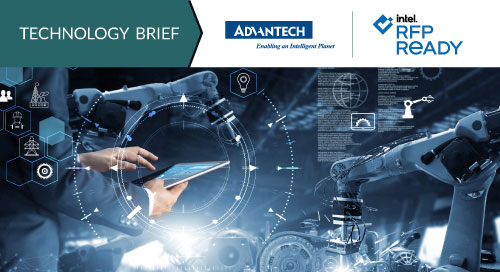High-Performance Compute + Azure IoT Edge Advance the IIoT

Is it possible to have too much of a good thing? For manufacturers using AI to gain insight from operational technology (OT) data, the answer is, increasingly, yes. OT assets now generate so much information it can’t be analyzed efficiently by cloud-based AI.
“The growth of Industrial IoT (IIoT) means that manufacturers are collecting a huge amount of raw data from the factory floor. But you can’t simply dump all of that to the cloud for processing,” says Penny Chen, Product Manager at Advantech, a manufacturer of edge computing solutions. “To send everything to the cloud is too expensive due to data transfer and storage costs. It’s also resource intensive, which can cause network performance and latency issues.”
This is a problem—but one with a clear solution: Perform a portion of the AI processing workload at the edge, pretreating and filtering OT data before sending it on to the cloud to extract further business insight.
The good news for manufacturers and OT systems integrators (SIs) is that edge AI appliances purpose-built for this task are now available. These flexible, ready-to-deploy solutions bring core AI functionality from the cloud right to the edge, offering efficiency, cost savings, and ease of implementation in multiple manufacturing scenarios.
Modular Edge AI with Azure IoT
Bringing cloud AI analytics to the edge might seem like an obvious answer, but it’s not without challenges. The key to overcoming those challenges is a modular architecture running on proven industrial hardware.
With the Advantech Intelligent Platform with Azure IoT Edge solution, for example, end users decide which Azure IoT modules are most applicable to their use case, and then deploy them from the cloud to an edge AI appliance. Advantech’s gateway software, EdgeLink, handles the important work of collecting and standardizing data streams from the various proprietary communication protocols used by industrial equipment—a major challenge when performing data processing tasks in industrial environments.
The local Azure IoT runtimes then perform whatever AI inferencing is required at the edge, before sending pretreated information to the cloud for additional processing.
There are a number of benefits to this approach:
- Performing AI processing at the edge reduces the total amount of data that needs to be sent to the cloud, cutting costs, reducing latency, and conserving network bandwidth.
- Data pretreatment at the edge means manufacturers can transform OT data into meaningful information, filter out what is unimportant, and select only the most relevant data for additional analysis.
- Edge computing offers near real-time insight into what is happening on the factory floor, offering safety and operational efficiency benefits.
Chen stresses the importance of modularity in industrial edge AI, and notes that the selection of Azure as an IoT platform was specifically driven by this concern: “With Azure IoT Edge, you have lots of different cloud intelligence modules that you can choose to deploy to the edge. This lets the end user focus on the business insight that they need, and nothing more.”
Chen says that the choice of Intel hardware was also driven by concerns of flexibility: “Our main concern is to optimize for edge AI performance and functionality, and Intel processors excel at this. And Intel’s wide range of processor options also means that we can meet a customer specification for just about any use case or industry.”
AI at the Edge in Multiple Scenarios
A flexible, modular design means that edge AI platforms can be used in a diverse array of industrial settings.
Advantech has already deployed its solution at a global tire manufacturing enterprise as well as with an OT SI serving the transportation industry in Europe. But of course, edge AI is useful in just about any scenario in which equipment monitoring, process optimization, and resource management are a concern—and that describes everything from factory environments and urban construction to energy production and logistics (Video 1).
Ready-to-deploy edge #AI platforms, built on proven, well-documented #technology, offer the opportunity to sell innovative edge AI-enabled solutions to customers without being hamstrung by technical barriers. @Advantech_USA via @insightdottech
For SIs serving these sectors, the availability of ready-to-deploy edge AI platforms, built on proven, well-documented technology, offers the opportunity to sell innovative edge AI-enabled solutions to customers without being hamstrung by technical barriers.
Solving Lingering IIoT Pain Points
The ability to deploy cloud AI processing logic to the edge is a huge step forward for the digital transformation of industry. But some issues remain: the complexity of data integration when working with OT assets; the significant time and effort required to handle the associated programming tasks; the difficulty of ensuring uptime at sparsely staffed or remote locations.
In response, vendors of edge AI-enabled solutions are attempting to simplify IIoT deployment and management for their SIs and end users.
Advantech, for instance, is developing WISE-Edge365, a no-code SaaS platform that will allow end users to provision devices and monitor data in real time—all from a preconfigured, industry-specific dashboard designed to help with data visualization.
“The goal is to offer an integrated, user-friendly platform that gives users complete connectivity and device management over everything, edge and cloud,” says Chen.
The upshot is as more manufacturing companies continue on the path of digital transformation, they will find themselves in an increasingly mature edge AI-enabled product marketplace, one in which the benefits of edge AI are delivered as seamlessly as IT services are today.
Edited by Georganne Benesch, Associate Editorial Director for insight.tech.